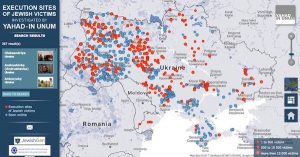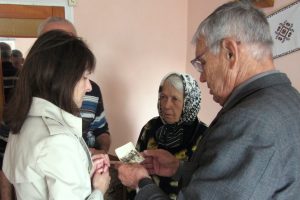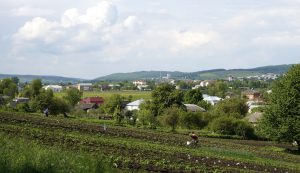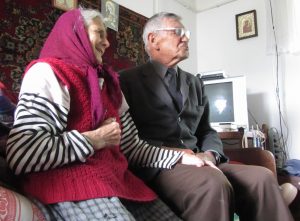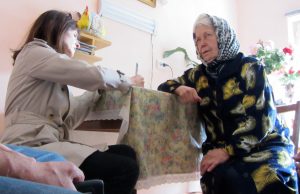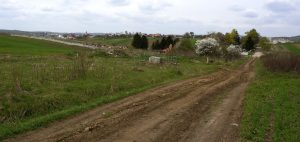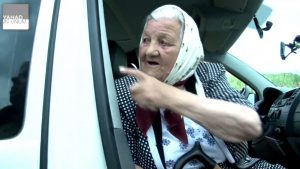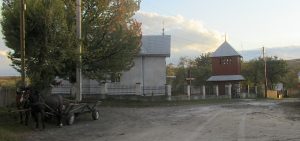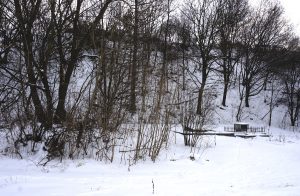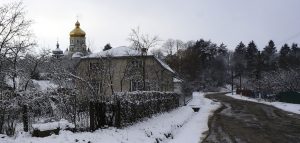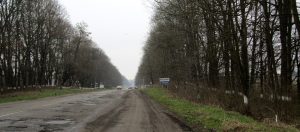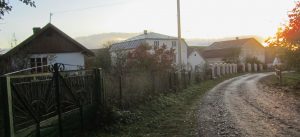![]() Ця сторінка також доступна українською.
Ця сторінка також доступна українською.
Introduction
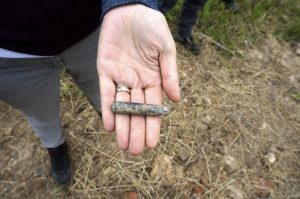
A wartime bullet casing found during independent survey work at Rohatyn’s south mass grave in 2017. Photo © 2017 Jay Osborn.
This page presents summaries of nine video-recorded testimonies made by Yahad – In Unum in 2016 of Ukrainian witnesses to events of the Holocaust in Nazi-occupied Rohatyn and neighboring villages. The testimonies also include details about life in Rohatyn before World War II; relations between local Jews, Ukrainians, and others before and during the war; and the concerns of local people during wartime and postwar upheavals.
Yahad – In Unum is a French organization founded in 2004 to research and document World War II execution sites and mass graves in the former Soviet Union. In addition to collecting forensic evidence of the “Holocaust by bullets” (genocide by mass shooting), Yahad records video testimonies of eyewitnesses to the killings and mass burials in the towns and villages where the crimes were perpetrated, and archives the video for further research and analysis. In many cases these recordings are the last opportunity to capture first-person accounts of the events and the local situations surrounding them. The videotaped testimonies serve to unsilence an aspect of the Holocaust which until recently has been under-studied: the mass execution of Jews and Roma outside of death camps, in the victims’ own towns and surrounding fields and forests.
To date, Yahad has made more than a hundred research trips in central and eastern Europe, recording more than 5000 testimonies concerning more than 2000 execution sites; Ukraine is heavily represented in Yahad’s work. As the information is processed by Yahad’s staff and volunteers, a database of details about executions is being assembled, and an interactive map connects the details to places.
Through partnerships with the United States Holocaust Memorial Museum and universities in Paris and Washington D.C., as well as independent international educational workshops, Yahad contributes resources and expertise to Holocaust scholarship and the study of mass killing, working to promote discussion and policy against ongoing genocide around the world. Yahad’s research and activism supports and influences both history and current affairs.
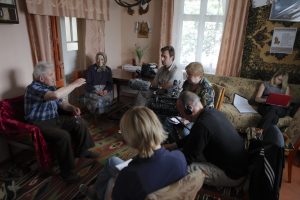
Yahad’s research team with a witness during the research mission in Rohatyn, June 2016.
Photo © 2016 Markel Redondo / Yahad-In Unum.
The interviews summarized here were recorded in or near Rohatyn during June 2016, in the witnesses’ homes and (in one case) at the wartime execution sites. The Yahad team included interviewers, interpreters, and videographers, all experienced in past work for the organization. Questions were asked primarily in French, interpreted to Ukrainian for the witnesses; answers and further discussion were in Ukrainian, interpreted back to French for the recordings. Linked to this page are full transcripts of these interviews in Ukrainian language; the summaries listed here were made in English (from the original French spoken by the Yahad interviewers) by Marla Raucher Osborn for Rohatyn Jewish Heritage, and we bear responsibility for any transcription/translation errors.
The witnesses who spoke to the Yahad crew were identified and selected through advice from local Rohatyn historians and elders. All of the witnesses were born in or near Rohatyn between 1922 and 1934, making them 8 to 21 years old at the time of the executions, and 82 to 94 at the time of the interviews. There are six women and three men, each recorded individually. Each witness agreed to speak about what they saw and heard of the executions in and around Rohatyn during the war. Witness names are omitted from the recordings by Yahad policy. Not all of the witnesses agreed to the use of their names and/or images in public; in the summaries below, that information is withheld where requested.
Practical and technical issues such as stray noise sources and other audio contamination hampered clear recording of some parts of each of the interviews, as is typical of field recordings. At times, unfamiliar local place names confused the interpreters and interviewers, despite efforts at clarification, plus these interviews and summaries are made difficult by gaps in equivalent terms across three languages. Some of the spoken information remains uncertain in the summaries listed here; we hope to improve and correct the summaries over time through new transcriptions of the Ukrainian and new translations to English. In particular we want to help Yahad honor the memory of the victims, and to respect the desire of the witnesses to document the horror that they witnessed and which still haunts some of them. Rohatyn Jewish Heritage also interviewed two of the nine Yahad witnesses, in 2012, but the testimonies recorded here are better and more complete.
The Rohatyn Jewish community was completely destroyed during the Nazi occupation. Only a small number of Jews from Rohatyn and nearby towns and villages survived the executions in the wartime Jewish ghetto, the town square, the mass grave sites, and the death camp at the end of rail transports; even fewer of those who lived were eyewitnesses to the mass killing, as they survived only by hiding. The unique value of these video testimonies is that most of those interviewed saw at least one of the executions and/or their aftermath with their own eyes, and they remember.
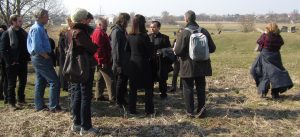
Marla and others with Father Debois at the Jewish cemetery and mass grave in Busk, Ukraine, in March 2011.
Photo © 2011 Jay Osborn.
The interviews are currently being processed for inclusion in Yahad’s growing database of execution sites and in their data-linked interactive map. We will update this page when the Rohatyn interviews have been connected to the map and other Yahad pages. We hope also to be able to share short clips from some of these testimonies on this page after Yahad has finished their own documentation work on them.
For more information about Yahad – In Unum and their ongoing work, see their website and those of their partners. For an introduction to their purpose and efforts, we can recommend The Holocaust by Bullets: A Priest’s Journey to Uncover the Truth Behind the Murder of 1.5 Million Jews, written by Father Patrick Desbois, founder of Yahad – In Unum. Rohatyn Jewish Heritage is proud to support Yahad’s work through volunteer efforts, communication, and friendship since 2009.
For more information about the location, history, and current status of the mass graves in Rohatyn, see the heritage sites map and the project page on this website.
Interviews
The interviews are summarized here in the order that Yahad recorded them. In the summaries below, record information refers to the Yahad database and numbering systems. The summaries arrange the witness information by topic; video time segments (usually of the French translation) are noted in hours, minutes and seconds from the start of archived video, in brackets: [MM:SS or HH:MM:SS]. Except where noted, all data and images are copyright 2017 Yahad – In Unum, used here with permission. Direct (translated) quotes from the witnesses and close paraphrases are indicated in italics; all other text is condensed and summarized. In some places, questions (Q) and answers (A) given during the interviews are indicated.
Identification of the mass grave sites in these summaries uses the common terms “south mass grave” (associated with the 20 March 1942 executions, located in farm fields on a light road from Rohatyn toward Putyatyntsi) and “north mass grave” (associated with the 6~8 June 1943 executions, located at the former vodokanal or water services facility, now a city industrial yard); see the heritage sites map for more precise locations.
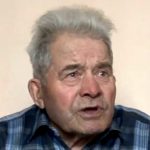 Witness #: YIU/2092U, male, born 1929
Witness #: YIU/2092U, male, born 1929
Yahad trip #: 45UK, recorded 10Jun2016
Record time: 01:40:30
Languages: Ukrainian, French
![]() Ukrainian-language transcription /
Ukrainian-language transcription / ![]() English-language translation
English-language translation
Background:
The witness was born and lived in the village of Verbylivtsi (pre-war: Wierzbiłowce), 1~2km south of Rohatyn [00:40]. He was 13~14 years old during 1942~43.
Q: Who made up your village before the war? A: All Ukrainians – no Poles, no Jews [33:11].
Q: Did you go to school in your village? A: At first yes, then my father had me go to school in Rohatyn [33:40]. If I recall, I had one year of study, and after that I went to professional school [35:07], but I didn’t finish my studies when we were deported (in 1949) [35:15]. Q: The school in 1939 then was Polish? A: Yes [35:54]. We were taught in Ukraine but in Polish language; after, when the Russians came, we learned Russian; then when the Germans came, we learned German: “Guten tag. Danke” [36:11]. Q: Were there Jews in your school? your class? A: No, Russians [37:00]. Q: Children of Russian administrators? Military? A: Yes. No Jews [38:12].
Q: Do you recall the Jews of Rohatyn before the war? A: Before the war, they had the power: they worked in the administration, commerce, all the stores, most of the houses [40:15]. Ukrainians worked the land. Jews bought the grain harvest from them and re-sold it [40:50]. Q: Did your parents have any Jewish friends? A: No, no, no [41:06]. Near here, in the second house, there were Jews, but I don’t know the name of the family [42:14]. In town there were only Jews, maybe one who was maybe Polish who had a post at the administration; there weren’t any Ukrainians (there), as they worked the land [42:50].
Q: Was there a synagogue? A: Yes, there was [43:02]. Q: Where? A: There were two, in masonry: one at town center next to the church, and one that after the war became a bakery; the building still exists, but I can’t say what it is today [43:26].
Q: Do you recall, how did the war begin at 1941? A: Of course I recall the beginning of the war: first the Russians occupied our territory in 1939, which then belonged to Poland, then the Germans in 1941, for ’41, ’42, ’43, then the Russians came back in 1944. I heard the announcements of war on the radio [45:25]. Q: First, the events of 1939, with the Russians: was there combat here? A: Yes [46:25]. There were war victims [46:30]. Q: In 1939, were there bombardments? A: No, not then; soldiers arrived with carbines [47:17].
Q: What happened when the Soviets evacuated? A: I can’t say; they left, that’s all. The Germans arrived and immediately got to work exterminating the Jews [49:42]. At the schools, primary and secondary, there were Poles, Jews, and Ukrainians all at the same school [49:57]; after, there were longer any Poles or Jews [50:00]. There was another school which was built in the village of Babintsi [50:07].
Q: When the Germans were here, did you continue to go to school? A: Yes. Under the Germans there were Ukrainians who taught us at school [51:15], including lessons in German language. Under the Russians, half the teachers were Russians and half were Ukrainians [51:28], but all the headmasters were Russian.
Q: Was your father mobilized? A: No, he was too old [52:29]; others were, and some ran away [52:40].
The Jewish ghetto in Rohatyn:
Q: How did the Jews live after the Germans arrived? A: At the arrival of the Germans, the Jews could continue to live in their houses, that summer [01:15:20]. The ghetto was created in Autumn 1941 [01:15:29]. It was a Jewish district; all the Ukrainians who lived there were displaced, and the Jews were gathered there, beside the river and the hospital [01:15:49]. Q: The ghetto was closed? A: No, it was forbidden to enter and leave, but not closed [01:16:45]. It was an area we shouldn’t go; I didn’t go [01:17:28].
The executions:
There were three aktions [01:15:58]. At the first aktion, 3000 Jews were killed [01:16:03]. Before this, they were gathered and brought to dig a pit; it was very large, I think maybe bigger than my entire house [01:16:13]. The Jews were guarded while they were digging the pit [01:16:19].
Q: Did you see scenes which affected you? A: It was very simple; the day of the first aktion, the Jews were put in trucks, like chickens or cattle [01:18:23] and killed at the pit; they were beaten up and slaughtered [01:18:37]. Q: What did you see? A: I saw the Jews assembled together at the town center; I did not see how they were taken from their houses [01:20:55]. After, they loaded them in trucks, like cattle, and brought them to the cemetery near Babintsi village where they were shot [01:21:18]. Before they were shot, a pit was dug. That was the first aktion, and they gathered all the people they could, but some succeeded in hiding themselves [01:21:31]. During the second aktion, the Jews were fewer in number, and the third aktion, even fewer, it was only those who could hide somewhere [01:21:49]. After the third aktion, there were no Jews left here and their houses were distributed among the people [01:21:57].
Q: The 1st Aktion was what year? what season? A: I don’t remember the date, maybe November or December the year after the Germans arrived; I don’t remember exactly [01:22:08]. Q: The ghetto still existed after the first aktion? A: Yes [01:22:54]. After the 1st Aktion, the ghetto was half empty, and they brought Jews from other places [01:23:17]. Q: Did the Jews who were gathered at the town center have their personal effects with them? A: No, they had nothing [01:23:23]. Q: Did they come to the center in a column? A: They assembled them at the town center as they could; some were pushed [01:24:26]; (the witness is agitated) they were treated like dogs [01:24:29].
Q: These Germans, where were they from: Rohatyn, or ? A: These were Germans from elsewhere. In Rohatyn, (normally) there were only ten or twenty German soldiers; this day there were many more Germans present [01:25:43]. I should say, one difference is that the Germans did this during the day; the Russians would have done this at night [01:25:53]. Q: Did the Germans have dogs? A: Yes [01:26:07]. Q: What color were the uniforms, the day of the first aktion? A: Black [01:26:09]. Q: How many trucks were there? A: There were two or three trucks, making round trips [01:26:51].
Q: This place where they were killed near Babintsi, it was a Jewish cemetery? A: No, it’s our cemetery [01:27:05]. In town, there are two Jewish cemeteries. The old one is in the center, on a hill, but there are no longer any headstones [01:28:34] because they took all the headstones to make roads [01:38:39]; there is a monument in the cemetery now. There is another cemetery located at the edge of the city beside our stadium; it is much smaller [01:28:54]. Q: You saw the pit? A: No, I didn’t because I didn’t pass by this route [01:29:45]. I saw it a long time after the war [01:30:01]. But I know from other people that after the Jews were brought to the pit and killed, the pit was covered by a bulldozer [01:30:13]. Q: Is there a monument there? A: Yes [01:30:18].
Q: Could you hear the shots that day of the first aktion? A: Yes, for sure [01:30:33]. But, I didn’t see the shooting because it was forbidden. The shots were isolated (not machine gun fire) [01:31:05]. Q: How far was the pit from town center? A: About 500 meters [01:31:40].
Q: The other aktions: did you see anything? A: (The testimony is incompletely translated [01:32:30].) Q: The same process? A: Yes. After there were no Jews left at the place, they distributed their houses [01:32:47]. Q: The area of assembly? A: The same place, on the square [01:32:59]. Q: What did you see of the second and third aktions? A: I can’t say, but I imagine that they (the Germans) had mastered the situation [01:33:18]. Q: Where did they (the aktions) take place? A: The same place (the cemetery). They were assembled at the same place and then taken away [01:33:50].
Q: During the first aktion, you were in town because you were at school? A: (The interpreters confirm: Yes [01:34:08]. Q: Did they speak about it at school? A: It wasn’t necessary, because everyone knew about it. Everyone saw what happened [01:34:46]. It was not an ordinary day – to kill people [01:34:50]. It was atrocious [01:34:56]. Q: Your teachers said nothing? A: No, no, no; the teachers said nothing [01:35:05]. No one spoke of the subject [01:35:13].
After the executions:
Q: How were the Jewish houses distributed? A: I don’t know how. I know that the houses were distributed, for example, to those who were moved here from Poland [01:36:41], or to someone who had owned it before [01:36:50].
After the war:
The witness, his brother, and his parents were arrested by the Soviets in late 1949 and deported to Siberia in early 1950, after being held for several weeks each in Rohatyn and Kolomyia. They were all held in Siberia and forced to work for ten years [02:00~31:00]. The witness and his parents returned to Verbylivtsi in 1959, and found that their house had been taken by Ukrainians who were deported by the Soviets from Poland [32:33]; the family had to rent a house until they could build another in the village [32:47].
Other remarks:
Q: Your father had been mobilized in the Polish army? A: My father was in the Austrian army [53:03]. He was born in 1895 [53:20]. When the Germans came, a lot of young men here joined the German Army – the SS, you remember? [54:11] Most left with the Germans, when the Russians came back. They (the Germans/SS) took anyone, even men of 50 who were otherwise too old. Q: Did the Germans have a recruitment office here? A: Yes (pointing over his shoulder) [54:52]. Q: Did you know men who signed up to join the Germans? A: Yes, I knew them, I knew all of them [55:12]. Q: What was their motivation? A: Look, there was a development of logic (a natural logical sequence): it was necessary to fight the Russians, so men joined the Germany army to do this [56:19]. After, when men were everywhere, and they began to lose (the war), they went everywhere to live: England, France, Australia [56:42]. Sometimes they came back here, but that is rare because now they are very aged [56:45].
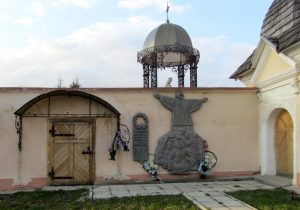
The memorial to the 24 Ukrainians killed by Germans in 1943 at the side of the church in Rohatyn. Photo © 2011 Jay Osborn.
Q: Were there Ukrainian nationalists here? A: Yes. Under the Germans, there were only the Ukrainian Police – temporary [58:35]. UPA was formed under the Russians to battle against the Soviet regime; the Russians made a lot of raids against young men [58:53]. They came into the village and arrested the young men [58:59]. Thus, it was necessary to do something [59:04]. There were killings and such [59:08]. Q: Were Ukrainians killed/shot here in Rohatyn by the Germans A: Yes, yes, yes [59:27]. Q: You saw this? A: Yes [59:57]. There was a shooting here at the central square, beside the church, on December 13, 1943 [01:03:26]. It involved 24 Ukrainians originally from Berezhany, Ternopil region, who were shot there. I recall we were going to school and we saw the soldiers pushing the crowd at the central square, so they would look upon the scene. They (the Ukrainians) had been lined up against the wall; the Germans were about ten to fifteen meters from them, and fired carbines [01:04:24]. There was another call to fire; I remembered this all my life [01:04:35] – the commander said “Ab acht” and they fired one more time [01:04:40]. When the shooting was over, the crowd went home. I was afraid to tell my parents what happened [01:05:01]. Today there is a monument at the edge of the cemetery to the Ukrainians killed [01:05:07]. Their bodies were taken and buried there [01:05:34]. Q: Who buried them? Germans? A: Locals; I did not assist because I was rather young [01:06:12]. Q: A common grave? A: Yes [01:06:35]. Q: What age were these men? A: 30, 40, 50, not sure [01:07:40]. Q: Why were they killed? A: I can’t say for sure, but Mr. Vorobets, who gave you my name, knows their family names and all the details [01:08:03]. You can ask him if you are interested [01:08:00]. Q: What effect did this shooting have? A: There was no discussion, just a list of the family names of those killed. A group was assembled to gather the dead and take them to the cemetery here, to dig the grave and bury them. No individual graves or tombs [01:09:20]. (There is more testimony following which is not translated.)
The witness gave permission to share his testimony and agreed to the public use of his name and image: Yes, yes, yes [01:40:12].
[Note: The first half-hour of this video testimony includes a considerable number of important details about the witness’s family’s Soviet deportation and the circumstances of his return; that information could be valuable to researchers studying aspects of post-war life in western Ukraine and Russia which are not covered by our work.]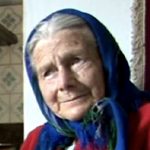 Witness #: YIU/2093U, female, born 1934
Witness #: YIU/2093U, female, born 1934
Yahad trip #: 45UK, recorded 10Jun2016
Record time: 00:28:35
Languages: Ukrainian, French
![]() Ukrainian-language transcription /
Ukrainian-language transcription / ![]() English-language translation
English-language translation
Background:
I was born here in Rohatyn [01:09]. I can’t tell you exactly when I was born because all my papers and documents were burned. People believe I was born in 1934 but I think it was earlier [00:52]. [The witness also states she was 10 when the Jewish ghetto was formed (August 1941); thus, she was approximately 8 (or 11) to 9 (or 12) years old during 1942~43.]
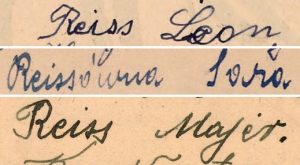
Signatures of students from the Reiss families of Rohatyn in the 1926 declarations of friendship with the US.
Q: You are of Jewish origin? A: Yes, I was Jewish. I am the only daughter of my mother. I married a Ukrainian and was obliged to become Ukrainian [02:58]. My father was named Feivel and my mother Amalia [03:36]; our family name was Reiss [04:50]. My mother was raised in the town (Rohatyn) [7:51]. Q: What did your father do? A: He worked in an office here, of a business that was involved in wood for building houses. My mother did not work; she was a housewife [04:29, 04:59].
Q: Where did the family live – in the town center? A: We lived in the center of town, but not exactly, in a house at the side of the church; we did not own this house. Today another house is there, built later [07:15].
The Jewish ghetto in Rohatyn:
When the Germans came, they encircled Rohatyn and no one had the right to leave [07:39]. When I was 10 years old, they started gathering everyone into the ghetto. My mother brought me to the ghetto; they had already begun killing the Jews. My father was an administrator, and he was killed; my mother had me leave; she took me to the road. My mother stayed and was killed [01:19].
Q: The ghetto was closed? A: The ghetto was there, where today is the market [13:11]. It wasn’t enclosed except by the Germans [13:16]. It was very tight; no one could leave; if they did they were killed [13:23].
Q: Your mother put you on the road to leave, to protect you? A: Yes [14:06]. The people in the ghetto did not live a long time [14:55]. My mom, before, bought a house to go to in the ghetto. When she took me to the road to leave, she told me to run away and keep moving. I never saw her (alive) again [15:20].
I left just when the ghetto was being created and the Jews being moved there; my mother learned of this and put me on the road [10:04]. She told me to go and that she would follow [10:12]. She did not follow – I was all alone [10:17]. I left and walked on the road, from village to village; I approached a house and asked for something to eat; after, I remember always having to look for a place to sleep [08:25].
The executions:
They created the ghetto and in the night there was an aktion [14:55]. During that night they killed everyone in the ghetto; there were bodies everywhere, everywhere [15:28]. After, I came back to look for my mother; they weren’t shooting anymore, but there were bodies everywhere [15:34].
My mother sent me and stayed in the ghetto. I left but I came back to look for her; I remember it was in the morning [11:52]. By the night, there were already a lot of people killed everywhere – I saw them in the courtyard and also next to our house [12:00]. I saw the body of my mother and did not recognize her [12:03]. Q: This courtyard was in the ghetto? A: It was in the ghetto, on the road of the ghetto [12:47].
When I came back to the ghetto, there were no longer any Germans and the bodies were being picked up – the dead people [19:43]. Q: How were they picked up? By cart? A: I don’t know where they took the bodies. Not far from here we have a hill called Red Mountain and there they dug a pit and it is here where a lot of Jews were killed, but today it is a place where people have built houses [20:52]. Q: You saw this pit? A: No [21:00].
Q: Your father – what became of him? A: My father was killed in the first aktion – he was one of the first of the Jews to be killed. He was brought beside the church to a wall and shot with the other Jews [24:35]. Q: When was this? A: I cannot tell you the exact date – my mother was still alive; maybe my mother was killed in the second aktion [25:32], because my father was shot before [25:35]. Q@25:43: Your father was taken from your house? What happened? A: Yes, they got him [26:04]. He was shot at the church like all the other administrators [26:20]. Q@27:29: Shot where? A pit? A: There is no pit beside the church, there is a wall where the men were shot. After, they took away the bodies but I don’t know to where [28:01].
After the executions:
After I left, I came back to Rohatyn to look for her (the witness’s mother); everyone was killed; my mother was no longer alive. It was the month of March. Before I had left, my mother had told me to look for a woman – a teacher at the school [08:09]. I walked from village to village [6:52].
I looked for a place to live [19:34]. There was a village – Zalaniv [10:20]. There was a man there I knew, he had a son, he took me in. There were Germans everywhere [10:32] but they never touched me [10:35].
Q: After you saw the bodies and you left, you went from village to village. And? A: I went from village to village until Zalaniv, and there I stayed alive [22:08]. Q: Did you stay there for the rest of the Occupation? A: Yes, later I married my husband there [22:43]. Q: Did the Germans come to the village looking for Jews? Did you hide? A: When I arrived at the village there were some Germans but they didn’t touch me and were no longer looking for Jews [23:55].
Q: Do you remember the name of the family that took you in there? A:
A: I remember: Popyk [23:34]. Vasyl Popyk became my father, and Maria Popyk became my mother [23:44]. They are dead now. Q: They treated you well? A: Yes [23:51].
Other remarks:
There were a lot of Jews saved in Lviv and Ivano-Frankivsk but not here [18:36].
The witness gave permission to share her testimony and agreed to the public use of her name and image: Yes, good [28:16].
[Note: Portions of this testimony were difficult to follow due to extended statements by the witness which resulted in gaps in the Ukrainian-to-French translations. This testimony would benefit from a full Ukrainian transcription, then translation.]. [Note: In our 2012 interview with this witness, she told us her given name at birth was “Zunca” (or “Zuntsa”). Additional information about her flight from the ghetto included this: She was walking along the Gnila Lipa River and saw Germans on the other side – they did not bother her; she stayed that first night at a Polish tanner’s house who had been a friend of her father’s; the next day, she came back to Rohatyn ghetto and was at the water pump by the mikvah near the river. She also said that her father’s brother, also named Reiss, had a soda business in Rohatyn. In addition to our visit (arranged by Mr. Vorobets), several Israeli people had visited Rohatyn to talk with her.]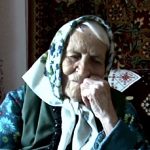 Witness #: YIU/2094U, female, born 1927
Witness #: YIU/2094U, female, born 1927
Yahad trip #: 45UK, recorded 10Jun2016
Record time: 00:37:02
Languages: Ukrainian, French
![]() Ukrainian-language transcription /
Ukrainian-language transcription / ![]() English-language translation
English-language translation
Background:
The witness was born in the village of Perenivka (pre-war: Perenówka), about 3km north of Rohatyn; she was 15~16 years old during 1942~43, part of a large family [01:15]. Her parents were household farm owners before the war; they grew everything which was needed for the family and traded work with other local people [01:47]; I’m not sure [how many hectares we had], but we were considered rich [01:35]. She attended school in Rohatyn because the village was too small for a school. There was a small church in the village; except for special services they went to the church in Rohatyn.
The village was all Ukrainian, including her family (It’s in my blood, as my father always used to say. [03:13]), and the school she attended in Rohatyn was also all Ukrainian, the so-called “native” school [05:16]; even Polish was not taught there in the Polish era [08:07]. Q: Did you have any Jewish children at your school? A: No. Jewish children probably attended the Polish school, but not the Ukrainian school [09:27]. Q: Were there many Jews living in Rohatyn before the war? A: Yes, lots [09:46].
The Jewish ghetto in Rohatyn:
Q: When the Germans first came, was the ghetto established right away, or were the Jews allowed to stay in their own homes for some time? A: At first the Germans didn’t bother them, but afterwards, when the ghetto was put up and enclosed so that they wouldn’t be able to get out, that’s when they started rounding them up [21:27]. Q: Can you tell us where was this ghetto located, which streets? A: Do you know our Church of Virgin Mary? Well, behind it there was a space. Q: How far did the ghetto stretch? A: I can’t remember exactly, but, as I’ve said, it started right behind the Church of Virgin Mary and stretched out until the stream. That was its territory [22:21]. Q: Was this a district in town that was populated exclusively by Jews? A: Yes, there were no Poles there, no Ukrainians either, only Jews. Q: But before the ghetto was established there, did other nationalities live there and then got evicted? A: Yes, yes. Q: Did you see how the Jews were moved to the ghetto? A: No, I didn’t go there [23:24]. Q: Was that area enclosed? And if so, was a regular fence or barbed wire used? A: I can’t remember for sure, but I think there was barbed wire. Q: Did you see that ghetto? Did you walk by it? A: Yes, I saw it, it was quite conspicuous. But I never entered the ghetto because my brothers always cautioned me: “Don’t go in there.” But from others’ stories I knew about it… Jews were very kind toward Ukrainians, they would help, because Ukrainians were poorer. If you needed some help, some clothes for the children, they could lend it to you. [23:52]
Q: Were the Jews ever led out of the ghetto to do work? A: I don’t know about that. Probably not. Q: Before the final operation, did you observe any scenes of cruelty and violence that was inflicted upon the Jews? A: No, I haven’t seen anything like that [25:41].
The second mass executions:
When they were being rounded up and marched to their execution it was impossible to watch, all those little children in their arms [09:46]. Q: The year that you saw that column in which the Jews were being marched, was that the same year that the Nazi occupation started, or later? A: I think it was in the same year [11:20]. Q: Do you recall what time of the year it was? A: Autumn. Children were attending school [11:45]. Q: Where were you when you saw that column? A: I was walking to school with a few children from our village, there were around four of us. We were walking on the side of the road just as they were being conveyed down the main street. It was horrible [12:02]. Q: Where were they being marched from? A: From the ghetto. Q: Was everyone on foot? Were there no carts? A: They were all on foot. They were being treated cruelly. Q: Did they have any belongings with them? Any suitcases? A: I don’t remember, perhaps. It’s a terrible pity, you know, because a person is a person, regardless of their nationality [13:10].
Q: Were they walking quietly, or crying? A: They were crying, screaming, talking amongst themselves. I remember there was one from our village, a little girl, a Jew. She was being hidden, disguised as one of us, you know. She’s in the village now, but I can’t remember where exactly [13:34]. Q: When you saw that column, were they being marched, like soldiers, or did they move in a less organized manner, like a crowd? A: They each walked in whichever way they could manage. But the poor people knew what was awaiting them… [14:37]. Q: Were they being guarded? A: Of course, by the Germans, so that they wouldn’t escape. Q: Were there many German guards? A: I can’t remember exactly, but I think there were plenty. Q: Did the guards have dogs? A: I can’t recall with certainty, but I think so. Q: Did you see the beginning of their column? Was there a rabbi present? A: No, no [15:23].
Q: Was it possible to communicate with the Jews in that procession? A: Of course not, it wasn’t allowed to even look in that direction, let alone talk to them. The people were beaten by those butchers, don’t you know how Hitler was? And afterwards came Stalin to replace him [15:42]. Q: Where was that column headed? A: They went where those monuments are now. There were so many people buried there that their blood kept seeping through the soil. They poured clay, they poured sand, but blood was still seeping through because so many people were slain [16:12]. Q: Where was that place exactly? A: At the sewage treatment plant. Q: Did you follow that column? A: No, this was in the opposite direction – I was walking into the city, they were walking out. I couldn’t have followed them anyway, I wouldn’t have been allowed, they wouldn’t even allow us to gaze in the direction of where they were headed [17:26].
Q: Did you hear any shots fired that day? A: Yes, I did [17:26]. Q: Were they solitary shots, fired one by one, or were they fired all at once, en masse? A: En masse. Q: This place where they were shot, is it far from the city center? A: Not far. Less than 1 km. Q: Is that already outside the city? A: Back in those days yes, it was outside the city. Q: Did you happen to go to that place a few days later, perhaps? A: Oh no, everyone was afraid to go there. Besides, it was probably being guarded, that place [19:22]. Q: How about that ditch, was it dug for this purpose? A: Yes, the Jews were made to dig it [19:36]. Q: Is that where the monument stands today? A: Yes, that’s what they say. I personally haven’t been there. Back in the day there was a brickyard there, with a sliding cliff close to where they were digging. I’m not sure how things are there now. Everyone was afraid of that place, you know [19:49].
After the executions:
Q: Did you ever discuss what you had seen with your teacher or classmates? A: Yes, well, everyone knew what happened. Q: But did you discuss it? A: No, of course not, that wasn’t allowed [20:58].
There was a forest nearby, and lots of Jews ran to the forest to hide. They were being captured and hunted down in there, but I don’t remember exactly, I don’t know, because I was just a kid. Q: So you didn’t see any of that? A: No. Lots of them ran away to the forest, they were somehow getting by in there, somehow they were feeding themselves. But afterwards I don’t know what happened to them [26:02]. Q: Was there only one operation against the Jews? Were they all murdered in that one act? A: I don’t know for sure, but probably they had more than one operation. That one was the biggest, but afterwards they probably hunted them down one by one and shot them. I don’t know for sure [26:43]. Q: What happened to the Jews that remained in the ghetto? Were they also executed? A: Many of them were hiding out throughout town, in people’s homes. People were hiding them in the attics, in the roofs, giving them food. But people were quite afraid of each other, afraid of being found out, Ukrainians were even afraid of other Ukrainians, because there were spies and informants everywhere… Many Ukrainians were saving Jews [28:30]. Q: Were there any Jews hiding out in your village? A: At the beginning – yes, but later no. They would come out from the forest, people would give them food. But afterwards, when people started running out of food I’m not sure what happened to them… Q: Were there any Jews hiding out in your family? A: No [30:04].
Q: Do you know what happened to their homes and property? A: I don’t know. But you know, some people were profiting from that, some people have no conscience. But we didn’t have any of that in our village… [30:22]
Other remarks:
Q: We would like to thank you for everything you’ve shared with us. One final question: may we share these insights with history students? A: Yes, why not [36:44].
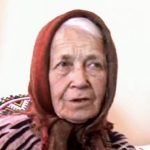 Witness #: YIU/2095U, female, born 1930
Witness #: YIU/2095U, female, born 1930
Yahad trip #: 45UK, recorded 11Jun2016
Record time: 01:13:21
Languages: Ukrainian, French
![]() Ukrainian-language transcription /
Ukrainian-language transcription / ![]() English-language translation
English-language translation
Background:
The witness was born in Lviv (pre-war: Lwów), the largest city in the region. Her mother died in childbirth; her father would not accept the child as his own, so at one week old she was sent to live with an aunt in Rohatyn [01:34]. Her aunt lived next to a factory. When the aunt had married, she and her husband built the house where the interview took place. As a child, the witness was weak, and nearly died, three times. The witness’s family is ethnically Ukrainian [06:15]; she was 12~13 years old during 1942~43.
Before the war, Rohatyn was much smaller; today many people are building houses [04:30]. Under Polish rule, the witness went to Polish school in Rohatyn; she was taught in Polish with some Ukrainian lessons. Jews were there also [6:10].
There were also Jews in my class. Rohatyn had about 7,000 before the war [07:48]. The witness does not recall names, but I remember a Jewish boy who was small and an orphan like me. He had lessons also with the rabbi. The rabbi would come to the school and give lessons to the Jews. The boy left for America; before he left he gave me a US bill as a gift [08:53].
In 1938, some Jews came to Rohatyn to try to get other Jews to emigrate to America – they had all the papers already prepared [9:51]. Before they left, they gave me $50 US to buy something. My aunt was also supposed to go with her fiancé and they also had papers, but the witness’s aunt was not prepared (or couldn’t get assistance) and so they stayed in Rohatyn [10:71].
The Jews were very religious: they celebrated holidays and didn’t work on Saturday; sometimes they asked me to light the fires for them on Saturday, and for that they gave me candy [11:43]. The majority of Jews were merchants. In Rohatyn, you had a lot of Jews, some Poles, and a few Ukrainians. The Ukrainians mostly worked outside the village in the fields [12:02].
Q: Was there a synagogue? A: Yes, at the center. The building still exists. It was big. It was transformed into a bakery after (the war) [12:25]. Once I saw a marriage at the synagogue, and assisted; many children would come to watch (these events) because they hoped to get something good. The fiancé broke a glass – they say this brings happiness. They gave all the children sweets [14:38].
Q: What language did the Jews speak? A: Their language, Polish, and Ukrainian [16:00]. The witness says she could understand some of the Jewish language.
The Jewish ghetto in Rohatyn:
Next to the church was the territory of the ghetto. To go to school, it was necessary to pass by it. I saw all that [22:27].
Q: The ghetto was closed? A: It wasn’t closed, but everyone knew where it started and ended. Jews occupied all the houses in the ghetto, where before there had been Poles and Ukrainians [23:08].
Q: Where was this area? A: The ghetto began at a house of a woman named Hannah who decorated dresses. She could not leave the ghetto and she would ask people to bring her things to eat: milk, bread [26:00]. Next to the school there was a passage where you could hide something and pick it up on your way back to the ghetto [26:46]. One time I brought her (Hannah) some food. She picked it up and suddenly fell down dead. She was so hungry. She had sores on her arm (the witness touches her arm) [27:00]. She died of hunger. After, I went to the Judenrat and told them that Hannah was dead [27:20]. Q: What happened to Hannah’s body? A: They took it to the Jewish cemetery and buried her. She was maybe 35 or 40 years old [31:09].
Q: Where was the Judenrat? A: (Pointing:} The building there that has the plaque on it [27:49]. A big building that still exists today. There was a young man there, but I don’t recall his name [29:00]. Q: Was there something at the time that designated the building as Judenrat? A: There was a store that faced it; it was a big building, created to be Judenrat [29:27].
Q: What was the inside of the Judenrat building like? A: An office [31:35]. The witness gesticulates and touches her garment. A number of those on the Judenrat wore a round red insignia on their chest so they wouldn’t be killed [32:25]. Q: Do you know what jobs the Judenrat had before? A: Some were teachers, high status, politically active [33:02].
Q: Were the Jews in the ghetto marked? A: Yes [34:06]. The ghetto territory was tight, between the church and the river [35:05]. All the Ukrainians were moved out, and the Jews brought into the area to be watched [35:16]. I saw the Ukrainians get moved out and the Jews moved in [35:32]. When the Jews had to move, they brought their things by themselves; it all happened on the same day [36:15]. Q: The ghetto was guarded, patrolled? A: No. The Jews could leave and look for food because at the time there was a problem with food; the harvest was not good; they would go to people for food [36:40].
Before the war the Jews were merchants. In the ghetto there was no longer any work. They stayed in the ghetto and waited for death [38:00].
The executions:
When the Russians arrived there was a lot of damage, but the war got much worse when the Germans arrived. The Germans shot the Jews; they entered all the houses looking for people to dig a pit; all the Jews were killed there [17:58].
Q: Did you see the shooting. A: Yes [18:56]. In spring, I was going to school with my friend; we passed next to the Church; we heard shots and saw a German; we decided to pass by quickly, saying to him that we were going to school. After, we saw a man who was shot next to the water tap [20:10]. It was spring, there was snow; we saw blood which ran and mixed with the deep snow [20:56]. I remember well, it was the 20th of March [21:10]. There were three aktions [21:18]. I saw five people killed. The Germans said to us “schnell, schnell” to get away and we were very scared [21:53]. Q: This was on the street? A: Yes, in the ghetto [22:27].
Q: The bodies you saw in the street – they were killed, why? Because they tried to escape? A: Some Jews tried to escape; some hid, I heard in cellars [40:08]. Maybe when they tried to escape, they were shot. Jews were hidden by some people who had big houses and basements. Q: You saw this? A: No, people told me [40:21]. Someone announced that the Germans were coming to make those hiding in basements come out; they used water from the river [40:31]. To save their children, the Jews in hiding passed them up into the hands of the Germans [41:06]; a German took one child and knocked it against a wall [41:12] and the child was dead. There were two children killed that way [41:17]. The witness states she did not see this, but heard it from her neighbors. This was the second aktion [42:30].
Q: In the first aktion – the Jews were killed where? A: Not far from Babintsi – they prepared the area, even Jews dug the pit; they were shot there [43:05]. There were Jews who were not wounded but they didn’t get up, so the pit was closed, and after, the ground still moved [43:34]. Q: You saw the pit? A: No, I wasn’t there, but you could hear the shots [44:01]. Q: What is Babintsi? A: It’s a village beyond Rohatyn; it’s where the first Jewish cemetery is, the old cemetery [44:30]. Q: Were Jews killed in the Jewish cemetery? A: Yes. There are 3 cemeteries next to each other in the area: Ukrainian, Polish, and Jewish. Q: Jews were killed in which cemetery? A: In the Jewish cemetery [45:30].
I heard the shots; I was at school during the first aktion [45:55]. Q: What did the teacher say? A: They told us they shot the Jews; that’s all [46:47]. Everyone was upset when they heard this [47:15]. Q: Did the lesson continue? A: Yes, but there were no longer any Jews in our class. I remember a friend; she went home every Saturday; she was no longer there [48:09]. We heard the shots, but the lesson continued [49:25]. Q: Shots from what? A: Carbine [49:40]. Q: When the class was over, did you go home? A: Yes [50:52]. Q: What was the name of your teacher? A: I don’t recall. Q: She was Ukrainian or Polish? A: Polish [50:37].
Q: Did you see cadavers where you were? A: No, not at school. Everything ended at the pit [51:40]. Q: Did you go see the pit? A: I remember, it was the second aktion, when they told me that they were taking people for shooting, my friend, named “Izia” [52:46]. (The witness becomes emotional.) I tried to follow her [52:57]; she saw me and called out “Farewell!” and I called back “Farewell!” We both cried. After, at my aunt’s, I told her I had seen Izia and tried to follow her to say goodbye, and my aunt groaned and said they took her with the other Jews to kill her [53:20]. Q: When was this, what season? A: In autumn [54:26], the year the Germans arrived [54:47]. Q: Were any shooters Ukrainian or Polish? A: No [01:12:26].
Q: You saw others being taken? Where were they, in the streets, or ? A: Yes, I saw them. They were taken by the road and then to the place where the Jews had already been shot, near Babintsi [55:05]. Q: There was a column (of Jews)? A: Yes [55:57]; they were in a column guarded by the German army [56:20]. Q: They were on foot? A: Yes [56:05]. Q: They had sacks with them, belongings? A: No [56:15], they had nothing in their hands [56:30]. Q: You discussed this with others, with your parents? A: Yes, with my parents [57:30].
Q: How many people were in the column? A: A lot; in the first column about a thousand, in the second (where Izia was taken), much less, perhaps a hundred [57:58]. Q: How did you see this? A: The road passed from the church, past a hill by the cemetery; there were a lot of people there [58:29]. Q: Germans were there, they had dogs? A: Yes, with dogs [58:50].
Q: Did you hear the shots of the second aktion? A: Yes, Rohatyn was small, we could hear everything; I was at the entrance to the school [59:55]. Q: Did you go to look at the column? A: Yes, I was at the side of the column when my friend came to find me [01:00:37]. Q: Did you see any Jews try to escape the column? A: No, they couldn’t – they were well-guarded with guns and dogs (the witness mimics holding a rifle) [01:01:30]. Q: Were the Jews crying? A: Yes, crying [01:01:28].
At school there was instruction in religion, Ukrainian, Polish, and Jewish. Those teachers of Polish and Ukrainian religion never said anything to me, but the Jewish rabbi asked me every day if I had enough to eat, whether my schoolmates shared their food with me [01:02:40]. Q: What was the name of the rabbi? A: I don’t know [01:03:40]. It wasn’t long ago that people who were saved returned here [01:03:50] (from America, with Mr. Vorobets [01:04:20]).
Q: About the third aktion, the column, did you see anything? A: I didn’t see the column, I was at school [01:04:55], but I heard [01:05:37]. They shot the Jews at a different place, on the other side, they had there a brick works [01:05:45]. Q: What is near there, a train station, ? A: It’s near the village Potik, in the direction of Stryi [1:06:09]. Q: This village exists now? A: Yes, there is a big restaurant there. I didn’t see it (the aktion). There is nothing there; the area is not maintained [01:07:05]. Q: Is there a monument, a memorial there? A: I don’t know [01:07:15].
After the executions:
After the third aktion, there were still some Jews in Rohatyn – they stayed until the Russians arrived [01:08:12]. Q: Who were they? What did they do? Were they specialists of some kind? A: There were Jews in hiding [01:09:19].
Q: Jewish houses afterward, what happened to them? A: The houses stayed empty after the Jews were killed, under the Germans; after the Russians came and the Germans left, Ukrainians moved in [01:11:07].
Other remarks:
The witness added that there was a (Ukrainian?) family that was also shot for hiding Jews [01:12:40].
The witness gave permission to share her testimony and agreed to the public use of her name and image: Yes, you may [01:13:04].
[Note: When describing life and events in Rohatyn, the witness generally uses the original Ukrainian term for Jews (“Zhydy”), a neutral term common to the older generation in the area. The translators always use the newer term (“Yevreyi”).] See our article for context to these terms in western Ukraine. [Note: In our 2012 interview with this witness, she also told us several of these stories, mostly focused on her life and interactions with Jews before the war; she remembered a number of Jewish surnames and some businesses. After the war, she recalled that where roadside walkways were paved with Jewish headstones, some older people in town refused to walk on them, as they considered to do so a sin.] 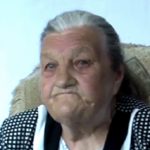 Witness #: YIU/2096U, female, born 1932
Witness #: YIU/2096U, female, born 1932
Yahad trip #: 45UK, recorded 11Jun2016
Record time: 00:48:41
Languages: Ukrainian, French
![]() Ukrainian-language transcription /
Ukrainian-language transcription / ![]() English-language translation
English-language translation
Background:
The witness was born in upper Babintsi (pre-war: Babińce Górne), a village which now forms an eastern suburb of Rohatyn; she was 10~11 years old during 1942~43. She states she is ethnically Ukrainian, but before the war she was Polish, because Rohatyn was part of the Polish state [03:01]. She was schooled through the 3rd grade, when the Germans occupied Rohatyn, and never returned to school after the war. Her parents were traditional, working the land [02:01].
Before the war there were lots of Jews, but she never had Jewish neighbors – the Jews were in Rohatyn; they were in commerce in Rohatyn [03:50]; they had stores and factories [04:16]. Q: Did you have Jewish friends? A: No [04:32].
Q: What was the first day of the German occupation like? A: They installed themselves in all the houses [04:58]. Q: Did the Germans move into your house? A: Soldiers did. There was a garrison here on the hill [06:14]. The entire village, including her family, fled to Pidlyssia (Podlesie, about 3km north of Babintsi) because of combat and bombings; after, they came back to their home [07:12].
The executions:
Q: What happened to the Jews of Rohatyn? What did you see? A: The Germans brought the Jews to Babintsi [09:46], and the Jews were required to dig a pit. Then they brought all of them there and they made a line at the edge of the pit and they were fired upon. They fell into the pit and some were still alive; there were some that were saved and hidden [10:22].
Q: Did you see the Jews dig the pit? A: Yes, for sure. I saw from the barn; they were watched by the Germans; as soon as they were done, all of the Jews of Rohatyn were brought there to be shot [11:19]. There was a tunnel in Rohatyn where a lot of Jews hid. One time, a Jewish child came out, was seen by the Germans and they killed all of them hiding in there [11:24]. Q: You saw all that? A: Yes, it was in the afternoon [12:08].
Q: How many dug the pit? A: A lot, all male, maybe 8 or 10. There were guards watching on the sides [12:27]. Q: Who guarded them? Germans? A: Germans [13:02]. Q: Did the Germans explain to them how to dig the pit? A: Yes, I saw them [13:42]. Q: How far away were you? A: 100 meters at the barn. Maybe three or four kids watched [14:59]. The pit was larger than my house [15:27]. There were a lot of Jews killed, and there were also a lot of Jews killed in Rohatyn even before that; they were brought by cart to this place [15:47]. Q: Were there houses nearby? A: No; it was near the Turkish cemetery [16:20].
Q: What happened to the Jews after the pit was dug? A: They gathered up the Jews in town and after brought them to the pit [16:50]. Q: How long after the pit was dug did the shooting begin? A: It was all done on the same day – as soon as the pit was ready, they went to gather up the Jews (in town) [18:25].
Q: How did the Jews come to the pit? By foot? In a column? A: Column, on foot. As soon as they were at the pit (fosse), the shooters fired and they fell into the pit [18:59]. Q: A big column? A: Great. Q: Who was there? Were there dogs? A: Germans with dogs [19:35]. Q: How many Jews? Did the Jews have their things with them? A: A lot, not sure. They did not have anything with them. Many were also brought there by cart [20:05]. Q: What was the demeanor of the Jews at the pit? Calm? A: Not sure, couldn’t say [20:12]. And the pit was deeper than this room [22:03].
Q: Did the Jews undress before being shot? A: No [22:30]. Q: Were they shot in groups? Small groups? A: Yes, by group, facing the pit [23:05]. Maybe ten to fifteen per group [23:40]. Q: Could you see the shooters? How many were there? A: Many shooters [24:07]. The Jews faced the pit and the Germans were shooting at their backs (witness gesticulates) [25:13]. The shooters had carbines [26:00]. Q: Were they shot in the head? A: I couldn’t see. Q: How were the Germans? Calm? Agitated? Excited? A: Calm [26:27]. I didn’t stay until the end; I was too little at the time [27:14]. I saw several groups get shot [27:46].
Q: After each shooting, what happened? A: Witness’s reply was that she couldn’t see but at the end, someone closed the pit [28:20]. Q: Was there a plank over the pit? A: No [28:50]. The witness says that at the end, bodies were loaded onto the cart and thrown into the pit; then it was covered [29:34]. Q: You saw the bodies? A: Yes. There were four carts [30:19]. Bodies were brought from town to the pit [30:41]. A local drove the cart. It was not the same day as when the Jews were killed at the pit, but one day later when cadavers from Rohatyn were brought by cart to the pit [32:39].
I know that there were Jews who tried to get out of the pit; those that did were shot [33:35]. Q: Did any succeed in get out? A: No [33:54]. There was a man who came; he was bearded like a Jew but was not a Jew – he lived on my street. He was also shot. He just came to look [35:30]. The Germans also shot Ukrainians – in 1941, on the side of the church; I didn’t see it but people told me, and I didn’t know why. Maybe because they had killed for Ukrainian independence [36:31].
Q: Were there other aktions here in Babintsi? A: No [37:05].
The interview continues [43:15] at the south mass grave memorial site. Q: What is this place called? A: Fields of Rohatyn (not Babintsi) [43:40].Q: Here where the monument is, is there exactly where the pit was? A: Yes, yes, the same place [43:59]. The witness states that she was not at this place, but at a barn by a house that used to be on a hill beyond where the car is now; the house and barn do not exist now [44:30].
Q: The column of Jews arrived on this road or another trail? A: Yes, this road, from Rohatyn [45:02]. Q: What was the weather that day? A: Like today [45:27]. Q: Did the Germans set up a security zone of some kind to keep people away from the pit? A: They chased people away, and people were afraid of Jews trying to get out of the pit [45:59]. Q: Did the Jews cry when they were being shot? A: No, they didn’t cry; they were men [46:57]. The column that day had only men [47:06]. The children and their mothers were in tunnels in the town [47:25]. I was young and I did not live in Rohatyn; I didn’t see that, people told me. I saw the column of men here [47:50]. Q: Where were women and children killed? A: They were killed in town and brought here (to the pit) by cart [48:21].
After the executions:
Q: After the aktion in Babince, were there any Jews left in Rohatyn? A: No [38:36]. There wasn’t another aktion in Rohatyn; maybe isolated shootings of Jews such as those hidden in the forest [39:02]. Many Jews escaped and hid in tunnels in Rohatyn; there were some hidden in our village (Babintsi); there were shootings from time to time when they (Jews) came out for food [39:44]. Q: Did you give food to any in hiding? A: Yes [40:01]. Q: Where were they hidden? A: There was a Jew hidden beside the river in Babince, in the mud [40:26]. Q: What did you give as food? A: Potatoes, bread, things from our house [40:48]. Q: Did this Jew stay hidden a long time? A: He left after the aktion [41:18].
Q: What happened to Jewish houses? A: Certain houses were dismantled, some sold; some things were taken and I don’t know where [41:55].
Other remarks:
The witness stated that beside the mass burial pit there is a Turkish cemetery with soldiers, from the time when her mother (born 1904) was a small girl [37:35].
The witness gave permission to share her testimony and agreed to the public use of her name and image: Yes, yes, yes, yes [43:13].
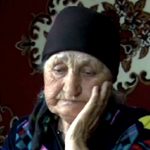 Witness #: YIU/2098U, female, born 1934
Witness #: YIU/2098U, female, born 1934
Yahad trip #: 45UK, recorded 11Jun2016
Record time: 00:50:00
Languages: Ukrainian, French
![]() Ukrainian-language transcription /
Ukrainian-language transcription / ![]() English-language translation
English-language translation
Background:
The witness was born and lived (and still lives) in Perenivka (pre-war: Perenówka), about 3km north of Rohatyn by roads; she was 8~9 years old during 1942~43. Rohatyn was Polish then [02:42]. Her parents were traditional peasants who worked 2 hectares of land in Perenivka; her mother had been born there but her father was from a town near Lviv. When the war broke out, the witness remembers air bombing and many refugees pouring into the village and into Rohatyn [03:58]. Some people moved into her family’s house, but there were too many so others slept in the barn. Her older sister and her sister’s husband were deported to Germany as forced laborers for 3 years; later, Germany indemnified them and they used the money to build a house [05:04]. There were Jews in Rohatyn, but I think they had their own school; there were no Jews in our class [07:34]. Under German occupation, there was no Ukrainian school; the witness went to Rohatyn School #1 and had lessons in German; her teacher was Rosalia Feduk from Babintsi.
In our village (Perenivka), we had one Jewish family – they worked the land like everyone else [08:39]. They had a daughter, with whom I played. The Germans moved them to Rohatyn; they were killed there. They moved in with a Jewish family next door to the hospital; a school was opened there. This house still exists today [09:34]. There was a Jewish woman who celebrated Christian holidays with us; she would wear Ukrainian traditional dress and participated in concerts [12:17].
The executions:
General: I can’t say what happened here in Perenivka. The witness was told that a Jewish woman was killed next to her house; she is not sure why because normally they did not kill people in the street [14:37].
First mass execution: It was in winter and the weather was tough. The witness’s mother had gone to Rohatyn to see a woman, and while she was there, shooting started, maybe of people who had been hiding in the forest. The mother told her daughter that there was an aktion by the Germans against the Jews and that they killed the Jews [15:00]. On that day, all the Jews were assembled at the town center (Roksolana); many were forced to be on all fours and stay there [17:39]. Q : Your mother saw that? A: Yes, at Roksolana Square, and my mother saw the Germans toss a baby over a balcony; it died; it was not crying [18:39].
Second mass execution: One day when returning to Rohatyn, I saw the column of Jews near the pit; they were digging the pit; I didn’t know why and asked; Jews were digging too; the column was 1 km long to the pit; there was a plank over the pit, and the Jews were made to walk on it, then shot and fell into the pit [15:23]. The column was long and had many Jews; it was managed/arranged by many people. I saw the column of Jews close to the pit; people tried to escape but they were killed on the spot [19:01]. There were a lot of executions – it was for that reason they dug the pit [20:10].
The witness describes the column as being like a parade; many people, and so long that that it was hard to see the end of it [21:44]. Q: Where was this column? A: To the right of the monument. On exiting Rohatyn, you see a pharmacy – facing that, 300 meters down the road; a column to the pit [22:17]. Q: Who guarded the column? A: Soldiers with dogs [25:59]. Q: Who was in the column? Were there women? children? A: Yes, even little children; some fell into the pit still alive, untouched by the bullets and still in their mother’s arms [26:59]. The witness did not see any carts in the column. I stayed a long time to watch the shooting; the column was so long you could not see the end [27:47]. Q: How many stepped out of the column and were killed? A: Twelve to twenty on the road [30:34]. Sometimes Jews escaped the columns, either solo or in groups of 2 or 3; some Jews resisted [42:31]. Q: The Jews who escaped the column and were killed, what happened to their bodies? A: I can’t say where they were killed, but people say their bodies were brought to the pit and after, the pit was covered [33:16]. I saw Jews killed, trying to leave the column, but I did not see how they were killed at the pit because the view was hidden/obstructed [30:03]. But one could hear the shots and crying [30:17].
Q: You saw the pit? A: I did not see it before the shooting but after where they constructed a memorial at that place; parents did not want children to go there and look; it was 1.5 km from Perenivka. I saw that Jews that tried to escape from the column were shot on the spot; the column was guarded [25:00]. There was a brick works there at the time; the pit was dug at the base of the cliff [23:23]. The brick works doesn’t exist anymore. Not far from the place, the brother of the Mayor built a house there [24:08].
Q: The Jews had their things with them? A: No, but before being killed they had to undress [28:16]. Q: You saw that? A: We were forbidden from seeing, but people said there were clothes left there [28:16]. After the Jews were shot, people went to the hill to look; I went too [29:20]. I can tell you I saw the column, I saw the Jews killed, I saw them fall into the pit, but I cannot tell you what happened in the town [29:32]. Q: Could you see the plank over the pit? A: I didn’t see it but I know that there was a plank that they put in advance; the Jews were put on the plank in groups; once killed, another group was put on the plank [31:13]. I did not have a view of this because I was hidden by the hill. At the entrance of Rohatyn – when you enter Rohatyn – before the former hospital, if you turn left you see a monument [32:48].
After the executions:
You still had Jews in hiding everywhere; for a month or even a year after, you had killings; they were not killed on the spot but brought to another place. I remember one killed in our village [34:23]. Q: You saw this in your village? A: Yes, my father knew him; the Jew looked at him and my father could do nothing because he too would be killed. I don’t remember his name [34:56].
Once my father went into the forest to pick mushrooms and he encountered a group of Jews hiding; they had 3 or 4 children with them. The children were very hungry; my mother brought them some food [36:36]. My father spoke to them in Ukrainian, which they understood because they were Jews from Rohatyn [37:21]. The next time he went into the forest he brought them something to eat from our house. I think that within a month they were killed, but no one ever really learned what happened to them; probably killed. At the time, a lot of Jews in hiding were found and killed [38:14].
Q: Were there Jews hiding in town? A: There were 2 hidden somewhere, I don’t know where; they were found [39:57]. A woman and her daughter were found and walked to a place where they were shot [40:21]. They brought them to Rohatyn to the place where other Jews had been shot [40:52]. I saw no other violence in our village [43:38].
Q: When you went back to school, did the students talk? To the teacher? A: No one spoke. No one wanted to remember [45:07].
After the war:
Jewish children wandered around the villages asking for food [20:33]. It was very difficult during that period. After the Germans left, the Russians arrived, and they came to demand milk to feed the small Jewish children who were famished. We pitied them; my brother and I ate nothing, we gave them all we had [48:18]. A Kolkhoz was formed; I worked there. There was little food, I don’t know how people survived for the first year; we had to search in the forest to survive. Today it is still difficult in Ukraine with the war in the east [46:03].
Other remarks:
I think of this often today. I wasn’t ready to talk then. I have trouble sleeping because of these events [20:23]. The witness gave permission to share her testimony and agreed to the public use of her name and image: Yes, for the young generation [49:40].
 Witness #: YIU/2100U, male, born 1930
Witness #: YIU/2100U, male, born 1930
Yahad trip #: 45UK, recorded 13Jun2016
Record time: 01:15:57
Languages: Ukrainian, French
![]() Ukrainian-language transcription /
Ukrainian-language transcription / ![]() English-language translation
English-language translation
Background:
The witness was born in Koniushky (pre-war: Koniuszki) [00:27], a village 10km south of Rohatyn and 7km north of Burshtyn; before the war, Koniushky was part of the Burshtyn district. He now lives in Verbylivtsi, a village 2km south of the center of Rohatyn. He was 12~13 years old during 1942~43; his experiences during the war were primarily in Koniushky but he also traveled with his father to Rohatyn and other towns to collect wood. His family before the war were Ukrainian peasants who owned a large house plus 20 hectares of land which was collectivized under the Soviets (as “kulaks” [01:50]; his parents were very sorry about losing their place). The family raised cattle which, before the war, they sold to Jews; they also harvested grain for sale in Czechoslovakia [03:29].
Q: Where did the Jews live to whom the cattle was sold? A: Many of them lived in Burshtyn; there was one man he remembers named “Dudiu” who bought live cattle from the family [04:35]. Q: Were there a lot of Jews in Burshtyn? A: Many there, but in his town of Koniushky there were only maybe three; two were named “Mottiu” and “Herschko” [05:33]. Q: What kind of work did the Jews of Koniushky do? A: Typical: cattle, and some worked for the Poles [05:49]. Q @: Were the Jews also in commerce? [07:20] A: At the time, working and traveling in and out of Koniushky was a bit of a nightmare because of bad roads connecting the village to Kalush, etc. Many Jews were merchants, some going from village to village with products for sale [08:03]. We also had some Polish people [09:19]. In 1939 the Soviet “liberators” arrived, and again in 1944; deportations started in 1944. Q @: What about your parents in 1939? A: Nothing happened in 1939, because the Soviets did not yet establish themselves in local power.
Q: Did you go to school before the war? A: Yes, in Koniushky. Koniushky was not big; it had about 20 houses and a school and a post, but no police [11:26]. Q: Did you continue at school once the Germans came? A: Yes [21:18]. Q: Was the school the same under the Germans? same teachers? same administrators? A: Mostly yes. Classes were still taught in Ukrainian, but the upper classes also had instruction in German and Polish [21:46].
Q: Were there German police in Koniushky? A: Yes, for sure; there was a police council for every village [31:25]. Q: What about local police under the Germans, were they volunteers or forced? A: A registration system was imposed in each town [34:10]. In his village, the witness remembers two Ukrainian police, one from Cherche, later killed by the Russians for being partisans; many partisans were hidden in bunkers in the forests [35:00]. Q: What about arms? and uniforms? A: Dark blue uniforms, hats with Ukrainian insignia, pistols, and submachine guns [36:31]. Q @: What role did they have? A: Monitoring others in town [37:00]. Q: Was there violence committed in Koniushky? A: In Koniushky there were no cases, but in Rohatyn, 21 young nationalists were killed against the side of the church [37:43].
The Jewish ghetto in Rohatyn:
Q: Do you know what happened to the Jews of Burshtyn? A: Not about the Jews of Burshtyn, but in Rohatyn all the Jews were moved to the ghetto [40:32]. Q: Did the witness see or visit the Rohatyn ghetto? A: Yes. At the time it was fenced but one could pass through [57:01]. Q: Where was the ghetto? A: Near the electric plant; about 300 meters behind the district administration [58:44]. Q: Was the ghetto in the Jewish neighborhood? A: No, Jews were moved there; some lived there before, others were moved there [59:44]. Q: Soldiers patrolled the ghetto? A: Yes, Germans [01:00:00].
Q: Did you see anything particular in the ghetto you would like to comment on? A: His father at one time bought him a suit from a Jew in the ghetto. The witness’s father could speak German and they let him in [58:14]. Q: So, your father went into the ghetto? A: Yes; he bought a suit at a Jewish house [01:01:40]. Q: You went into the Jewish house to buy a suit? A: No, not into the house but into the courtyard; I tried it on and bought it [01:04:24]. Q: Did your father exchange something for the suit? A: Of course – money [01:04:33]. Q: Did other people come through the courtyard? A: Sure, other poor inhabitants, as in a prison [01:05:05].
The executions:
Q: Did you see anything of the events which happened between Germans and Jews in Burshtyn? A: Not in Burshtyn; I saw more in Rohatyn [40:59]. One time I saw a shooting in Rohatyn. I was with my father in the forest (collecting wood) [41:30]. The witness and his father were coming out of the forest from the direction of Zalaniv, and were outside of Rohatyn, and they saw two large pits; it was the Jews themselves who had dug them [42:29, 43:45]. His father had been cutting wood, while he played [44:27]; they had a cart, and were on their way home. Q: What exactly did you see that day? A: When we exited the forest we stopped about 150m from the hill. We passed very close to a column of Jews; they were killed – there was a kind of bridge or plank across the pit; they were forced to walk on it; people said that about 3000 Jews were shot but I think they could not kill 1500 people per day [46:27].
Q: Where was this column of Jews in Rohatyn? A: The column was already beside the pit when I saw it; the Jews were brought to the pit; they were encircled by guards [47:00]. We were on our cart on the road; it was forbidden to stop on the road; we exited the forest and then saw it (the pit) [48:52]. Q: Where exactly was this pit? A: Next to it was a brick place for building houses; it was there that they were close to the pit [49:14]. Q: Did you see the shooting? A: You could see from the road – the people were standing on the side of the pit [50:17]. Q: You saw the shooting or were told about the shooting? A: Yes, I saw the people fall; I could not see the plank or the pit; but afterward, people told me about it; someone fired; someone fell [51:00]. Q: Could you see the shooters? A: They were German. Q: How many shooters? A: I don’t know for sure. I have never lied. I would say there were a lot of soldiers, maybe 500 soldiers encircling the people [52:52]. Q: The soldiers had dogs? A: Of course [53:15]. Q: What were (the shooters’) uniforms? Color? A: Green, but I’m not sure if SS or some other type of soldiers [53:35].
Q: How many Jews fell? There were men, women, children? A: Everyone, maybe a thousand, I’m not sure, brought from the ghetto [54:00]. Q: Were the people organized, separated into groups? A: I can’t say for certain; I only saw them at the side of the pit [55:30]. Q: Were the people at the pit dressed or undressed? A: The witness could not say [56:36].
After the war:
Q: Were there Jews in Koniushky? A: They all fled before the Germans came – there were only 3 or 4 remaining in this nightmare, hidden [38:14]. Q: What happened to their houses? A: One was burned, another was occupied by Ukrainians displaced from Poland. The witness is not sure if the building still exists because he left Koniushky in 1947 [40:15].
Q: What about your parents, under the Soviets? A: Nothing happened in 1939, but things became worse in 1944. A (Soviet) garrison was established (in the village) in 1946. A Soviet colonel was installed in his parents’ house; the colonel was Jewish [14:33]. This colonel told the witness’ parents to leave. The witness cannot recall the Colonel’s name, but recalls that his son was killed in a nearby village in 1947 [17:50].
The witness’s parents fled, to avoid deportation to Siberia. His father was able to procure a passport (difficult at the time in Koniushky) [18:44]. Q: Were other people in Koniushky deported by the Soviets? A: About fifty; those that were rich or had liaisons with UPA [19:16]. They left during the night; they did not have time to gather their things and prepare for the journey [20:15]. Q: Did these deported families come back to Koniushky after the war? A: Half of those deported died over there; many children died on the transport [20:33].
Other remarks:
The witness describes a debt of gratitude owed by his family, his father and his uncle, to a Jewish man who ran a factory, and to people at a Jewish theater in Lviv (this needs further detailing) [01:12:00~01:14:30].
The witness gave permission to share his testimony but did not agree to the public use of his name or image.
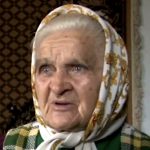 Witness #: YIU/2101U, female, born 1924
Witness #: YIU/2101U, female, born 1924
Yahad trip #: 45UK, recorded 14Jun2016
Record time: 01:23:34
Languages: Ukrainian, French
![]() Ukrainian-language transcription /
Ukrainian-language transcription / ![]() English-language translation
English-language translation
Background:
The witness was born and lived in the village of Verbylivtsi (pre-war: Wierzbiłowce), 1~2km south of Rohatyn, at the site where the interview was conducted. She was 18~19 years old during 1942~43. The witness, her younger sister and their parents had lived at the house before and during the war. When she married after the war, she moved to another village with her husband. She built her present house on the site of her parents’ house in Verbylivtsi, later.
Q: What did your parents do before the war? A: My father was director of a sugar beet factory in Khodoriv (about 25km away) [03:25]. He rode at night by truck from Rohatyn to Khodoriv, to bring sugar beets to the factory [24:00]. He was not home a lot, spending a lot of time at the factory. The witness’s mother raised the children and worked the land; the witness’s parents were peasants in traditional Ukrainian sense. If there was surplus from the harvest, they sold it after the family took what it needed. Before the war, the witness attended school with a Ukrainian teacher, but she also had classes in Polish [12:43].
Q: Do you remember the different kinds of people living in your village before the war, Ukrainians, Poles, Jews? A: In the village there were only Ukrainians. Sometimes Poles were here but they didn’t live here [10:20]. Q: And in Rohatyn? A: In Rohatyn there were Ukrainians and Jews. Most of the Jews occupied themselves with commerce, they had the shops. The Jews were better educated than the Ukrainians; the Ukrainians worked the land [11:25]. Q: Were there specific Jewish stores that you recall? A: I don’t remember any [12:03]. Q: Do you know of any other Jewish places in Rohatyn? A: No. Q: Did you go to church here in the village? A: Yes, here, but for large celebrations we went to the church in Rohatyn [13:10]. I also went to the Roman Catholic church sometimes to watch the mass, which was interesting [13:25]. Q: Did you see any synagogues in Rohatyn? A: No [13:45].
The witness states that, before the shooting, the Jews sold off a lot of their personal effects and things to get money to buy food [31:20]. People say that because the Jews no longer had any belongings, they came around asking for food [01:14:20]. When asked whether there was a Jewish ghetto in Rohatyn, she replies, maybe, but she never visited it [01:14:18].
The executions:
My father was working in Rohatyn, in the collection, loading, and transport of beets for his factory [28:28]. He often found himself at the town center, and sometimes I went with him there. One time, I went to give my father some food. There was a column of Jews just in front of the building (where her father was working). There were many, men, women, and children, in the column. There was a woman, I don’t know how she managed to escape from the column, or if it was my father who took her from the column, but we hid ourselves with the woman in a garage [29:03]. We stayed there the whole time, to the end of the shooting [29:05].
We stayed hidden until the end of the shooting, then the woman asked my father to take her someplace to join her family outside of Rohatyn, I don’t know where, but not here [29:55]. The woman gave me her bag, to say thank you, because I spent the whole day with her. My father sent me home to get clothes [42:58], and he gave her an embroidered shirt, a Ukrainian shirt, and a skirt [30:20]. After changing, my father took her to join her family. I don’t know all the details; I was young and didn’t understand everything, only that we gave her clothes and then took her somewhere by cart [30:40]. After the war, I never saw her; she promised to contact us if she managed to survive the war, but after, we had no news of her; even when I went to Ivano-Frankivsk I looked for her but I never saw her [31:05]. Q: Did you know the name of the hidden Jewish woman? A: She was about thirty, I don’t know her name, it wasn’t the time to ask, she was trembling with fear, she had seen what was happening to her people; I didn’t think to ask [32:12]. Q: Was the Jewish woman a friend of your father’s? A: I don’t know [34:15]. The witness could not recall exactly when these events happened; she believes it was around the time her mother died (1943), but can’t say whether it was just before or just after [35:40].
Q: What kind of work did the family of the girl your father saved have? A: I don’t know; only father talked with her, and it was wartime, I had my own chores and concerns [01:00:02]. We did not speak about what was happening; at this moment I was afraid for the woman, I could sense the woman was afraid for her people and herself, there was a small window in the garage and we could see the column passing by [01:21:04].
Q: Do you remember what the weather was like on the day of the aktion? A: I don’t recall, but it wasn’t raining [01:10:20]. Q: You saw the column of Jews? A: Yes. It started in Rohatyn and headed in the direction of the train station. Before that, it turned to the right and passed by the building where her father was working that day [01:01:09]. Q: What kinds of people were in the column, and how many? A: Old people, women, children, a very large number of people. Jews were found everywhere, even those hiding [01:03:32].
Q: Did the Jews have personal effects with them? Were there trucks to transport them? A: I saw no trucks; everyone was on foot [01:05:17]. Some people fell down; they were picked back up. The crowd was going crazy. Those Jews who were not shot (in the column in town) were taken to the hill, where they were shot [29:10].
Q: Did you hear the shots on the day of the aktion? A: I don’t remember – maybe; everyone was terrified [01:10:10]. I remember hearing exchanges of fire between the Germans and Russians [01:18:45]. Q: After the aktion, did anyone go see the pit? A: Oh, no, no one; I never went [01:12:40]. Q: Where exactly was the pit located? A: On the road toward Babintsi there is a hill – the pit was beside this hill, in that direction (pointing) [01:08:09]. I can’t say whether it was the Jews themselves or someone else who dug the pit; people said different things [29:20]. I heard that the Jews were shot and fell in the pit. There were some who survived and were killed by bullets [29:36]. I did not see this, but people say that many Jews fell into the pit still alive; I don’t know what happened after, but I heard that during the night, some Jews were still alive, and crawled out and went into hiding – but I did not see this; this is what I heard [01:08:45].
Q: Were all of the Jews of Rohatyn killed that day? A: Jews were marked, they had distinctive signs, different from the other villagers, so it was easy to distinguish them; many hid in the village and in the cemetery [01:12:03]. I don’t recall what type of sign they had. Some were in hiding in the villages, but we weren’t aware [01:13:31]. Q: Was there another aktion before this one? A: I couldn’t say [01:13:48].
Here, there was a very, very pretty Jewish girl with long black hair who had been hiding with her brother; they came to my house several times, two, I think, to ask for food. They didn’t come by the road but passed by my bedroom; I gave them food. But after, they disappeared, and people said they heard the Germans report that they had been captured and killed [01:03:51].
Q: Did you keep the bag the woman gave you? A: It is a long story about the bag; I couldn’t keep it. When the woman gave me the bag, I felt pressure, not because it was made of gold, we didn’t have a concept of gold, there wasn’t any in our village [53:50]; but I kept the bag for a while. My two uncles wanted to go to the US, but they couldn’t bring their wives, two sisters, with them. The wives didn’t want the men to go alone, because they thought the men might find other women to marry there, they didn’t trust their husbands. (There is more information in the translation.) In the end I gave the bag to my uncle as a gift for his passage to the US [55:20].
Other remarks:
I want to tell you about my brother, who was older than me [43:15]. He was in German school; one school day he and the other boys at the school disappeared. I learned later that the Germans had taken the boys somewhere by force. People said it was SS soldiers, but I can’t say, we had no information. They were gone a long time; my brother told me later that the Germans made them do various things, in a basement, and in water, by force. He stayed there and could not return, and all the while my mother heard no news [44:01]. It was long after the war that the family received news that the brother was living in the US. The witness states that she tried to convince the Soviet authorities to let her brother return, but they refused, so he married a woman in the US whose family was from the Lviv region [47:00].
The witness gave permission to share her testimony and agreed to the public use of her name and image: Yes [01:22:40].
 Witness #: YIU/2102U, male, born 1922
Witness #: YIU/2102U, male, born 1922
Yahad trip #: 45UK, recorded 14Jun2016
Record time: 01:54:32
Languages: Ukrainian, English
![]() Ukrainian-language transcription /
Ukrainian-language transcription / ![]() English-language translation
English-language translation
Background:
The witness was born and lived in Perenivka (pre-war: Perenówka), about 3km north of Rohatyn by roads; he was 20~21 years old during 1942~43. He states he went to school in Rohatyn; the building still exists today. His parents before the war were farmers, they had animals and land; the witness helped them in the field when he was not in school.
Until 1939, the region belonged to Poland [02:33]. In 1939, the Germans occupied Poland and western Ukraine, which was Polish. Once the war broke out, the Soviet Union occupied the western part of Ukraine and Germany occupied Poland. The Jews that were living then in Poland fled east to western Ukraine [03:47]. That’s why there were a lot of Jews in Rohatyn – about six thousand [03:54].
Q: Were there Jewish children in your class? A: My school only had Ukrainians (no Poles, no Jews) [07:37]. There was at the time one primary school and one secondary school (post-5th grade). When the Russians arrived, everything at school changed: they made the primary school like a secondary school and there were professional lesson for teachers [08:02]; Ukrainians, Poles, and Russians attended, but no Jews [08:07].
There were a lot of Jewish shops, and products in the shops, under Poland [08:19], but when the Russians came, they looted everything. Under Poland, Jews had another name: “zhyd” [08:41]. The Russians forbade the use of this word; anyone using it was subject to imprisonment for one year [08:59]. Q: Do you remember any names of Jewish families or Jewish professions in Rohatyn? A: No, not names [11:00, 12:12]. I know a lot about Jews [11:26]. For example, here in Rohatyn there was a synagogue, and near it was a rabbinical school [11:32]; lots of young men dressed in black with payot (side locks; the witness motions where on the side of the head these would be) [09:34]. There was also a cemetery situated at Red Mountain [11:48], from Rohatyn in the direction of Perenivka, but you will not find any traces of the cemetery now because the Germans destroyed it, they took the stones to build the roads [12:05].
I don’t remember the names of Jews who lived in Rohatyn, but there was one family in my village (Perenivka). They were our neighbors, and I can tell you that there was no difference between us and them [12:20]. We were all the same, we went to the same places, we talked with them, everything was OK [12:30]. This family had a shop, but they also had a field and horses; they did farm work as well [12:39]. Q: Describe the synagogue in Rohatyn: wooden? stone? A: The synagogue was a stone building, very big – I entered inside but didn’t stay long because it was forbidden. The walls were painted, that’s all I saw [14:14].
I will tell you the truth: at that time, people in the villages didn’t like Jews very much [01:19:41], because the Jews made trade and small business, and Ukrainians at that time were not literate, didn’t understand the prices, how many grams the Jews gave them, so they believed what the Jews gave them. Jews from time to time speculated on that, and so locals didn’t like them very much [01:20:13]. Q: But you had Jewish friends? A: I will tell you the truth. With those Jews in my village, we had very good relations [01:21:48]. They were my neighbors [01:21:53]. The old man even taught me how to write my first name and last name in Jewish language [01:22:04]. The family had a shop; they didn’t have the rights to sell (certain controlled items), so they gave us matches and cigarettes, and my father and I sold those things for them [0:22:24]. We trusted them, they trusted us [01:22:27]; everything was good, they gave as a salary a package of cigarettes to my father [01:22:35].

The signature of the student M. Schneekraut of Rohatyn in the 1926 declarations of friendship with the US.
Q: Do you remember the names of your Jewish neighbors in your village? A: Schneekraut [01:22:56]. It means “snow” and “cabbage” in our language [01:23:37]. The old man who taught me some Jewish words was Yankel; his son was Shia; the son was married to Maria [01:24:02]. They lived in a very good house, bigger than ours [01:24:08] because they had shops and also had a field where they worked. When they moved to Rohatyn, a club was made in their house [01:24:22]. Shia and Maria had two children [01:26:05]; in the village, there were rumors that Shia was not the father of one of them – but these were just village rumors [01:26:17]. The boy child was killed and the girl – whose name was Tsilia [01:26:25], was 4 years old at that time and she was spared; she was saved, a local man from Zalaniv hid her in his house, so she survived the war [01:26:39]. After the war, she came back and married a local Ukrainian; they lived in the family home (in Perenivka) for a while, then moved somewhere. But she is still alive [01:26:58].
I would like to say, that people knew the war would begin [14:33], because under Poland, the Ukrainian nationalist organization was very strong, they had connections, so we knew war was preparing; we knew Germans would come but not the exact date [14:52]. Q: How did you learn this? By radio? A: We saw the planes, they were bombing Rohatyn [18:31]. As I said, we didn’t know exactly when the Germans would arrive, even the recruitment office didn’t know. At that time I was a young adult and old enough to be enrolled [18:52]. All the boys of my age were gathered at the house of culture; we were about 15 of us, there was an orchestra, we were arranged in columns by fours [19:09] and went to the stadium where there was a big scene; officials from the district and the region made a speech that they knew Germans were preparing for war but we will push them back and they will not come on our territory [19:45]. At this time there was bombing at Khodoriv and planes were arriving [19:45]. On one side, the Soviet officials told us there was no war, and on the other side were German planes, so we understood that the war had begun [20:02].
I went with my friends to a hill and saw Russians in the village (Perenivka), they were about to withdraw [23:42]; three hours later the Germans arrived. The bombing lasted a week [24:02]; for a time there was a short pause when there were no Russians and no Germans in the village, it was empty with no administration [24:12]. When the Germans arrived, we went to the village and villagers told us that the Germans arrived and that Ukraine was liberated [24:28] and that there were Ukrainian flags on the town hall in Rohatyn [24:32]. My friend and I went to Rohatyn to see if it was true; when we arrived, we saw a truck of Germans who were drinking beers and very calm. People were walking in the streets as if everything was normal [24:49]. Where the statue of Roksolana is today, there was a statue of Lenin, and Ukrainian nationalists pulled it down [25:04]. When the Germans first took this territory, they moved forward and left this area for Ukrainians, there were no Germans [27:30]. The independent country of Ukraine was created [27:43], and members of the Ukrainian national organization were appointed to survey order in the town. We had weapons [27:57] and blue-yellow armbands so people could recognize us, and we were appointed to guard the administrative buildings and key places like warehouses [28:11]. But maybe one month later in Lviv, when the Ukrainian national organization was arrested by the Germans, our local organization in Rohatyn was dismissed [28:28]. Meanwhile, we had managed to stock a lot of weapons which we took to the villages, and hid them [28:34] until 1944 when the village was liberated from the Germans. In 1944 there were partisans, so we gave them those weapons to fight against the Russians [28:47]. When the Germans arrived and installed their administration, they created a ghetto [28:52].
The first months, the power was under the Ukrainian nationalists, but then the Germans dismissed it, and installed themselves in power [01:37:40]. One day, the German commissioner came into the village and made a speech in German which a local teacher translated into Ukrainian. I was present for the speech. He announced that from that day, the power was German, so the administration was German, all national organizations were forbidden, all national flags forbidden, and the people could no longer show their sympathy to national organizations [01:38:49]. Taxes had to be paid on products and if not paid, violators would be shot [01:38:57]. German discipline had to be respected, so no thefts, an discipline in the streets, everything should be according to German rules [01:39:13]. A lot of people, when they heard all this, they realized that the Germans had not come to liberate Ukraine but to occupy it [01:39:30].
Q: In your village at this time, there was a new chief elected? A: He was not elected, he was appointed by the Germans [01:40:53]. It was the same as under the Soviets; there was a local chief appointed by the NKVD. Under the Germans, the main function of this chief was to give a list of people who should be deported to Germany for forced labor [01:1:41:19]. In our village, only those not useful for the village were deported, or who were troublemakers. Q: At the end of the war, what happened to this chief? A: When the Russians arrived, he was deported to Siberia, but he came back after [01:44:01].
Q: At the beginning, you were a member of this nationalist organization? A: Yes. The first branches of this were already beginning to form in 1940. There was a branch in a nearby village [31:46], and a member of of that organization came to our village and proposed to boys to join. There were different levels of this organization according to age [32:01]. I was in the youth organization first, then was transferred to the adults [32:10]. When my organization was dismissed (by the Germans), I continued my studies and finished courses in German language, studied in a commercial/professional lyceum, then I worked in a shop. So I witnessed everything that happened in Rohatyn [32:39].
The Jewish ghetto in Rohatyn:
Q: Was the ghetto set up as soon as the Germans arrived, or later? A: The ghetto was established about one month after the Germans arrived. The first month was used to set up administration [01:33:02]. The ghetto was at the center of town: it spread from the church to the river, and from the current post office to the river. The Jews were gathered into this area [32:58]. Q: Did they bring Jews from other villages and cities to the Rohatyn ghetto? A: All the Jews from villages were transferred to Rohatyn. Before the war, a bigger village might have had five to seven Jewish families; they were not numerous in the villages. In our village, for example, we had only one, our neighbors. Once the Germans arrived, all the Jews were transferred to Rohatyn [01:19:33].
Q: When your neighbors in the village (Schneekrauts) were moved to the Rohatyn ghetto, did they move themselves? Did the Germans come to your village and force them to move? A: They went by themselves [01:28:28]. We had very good relations with them; they were very good neighbors, so we respected each other [01:28:57]. During the holidays they didn’t work, they didn’t even make a fire so they asked me all the time to do this for them [01:29:08], and for that they gave me some tasty food as a thank you [01:29:14]. They left by themselves – it was in October 1941 [01:29:23]. Before they left, there was an episode: someone threw a grenade into their house [01:29:30]; it was not functional, but still they were afraid [01:29:36], so they asked my advice, what should they do, and I advised them to move to Rohatyn; we did not know if Germans would come and kill them, so they decided to move to Rohatyn [01:29:50]. I knew who threw the grenade into the house [01:30:48], because before the Germans arrived, there was NKVD and Russians in the militia, and two Russian agents stayed in the village when the Germans arrived and they pretended to be Ukrainians Nationalists. So they had weapons and grenades, and put on armbands. When the real Ukrainian nationalists learned of this, they killed them [01:31:35].
There was a Jewish Police [33:01]. They didn’t have uniforms but a kind of kepi with the Star of David on it [33:10]; they were not armed but they had batons [33:13]. They lived there for a while, but not for a long time, because the first aktion was conducted on March 10, 1942 [33:25]. Q: What were the duties of the Jewish Police? A: They watched the ghetto and kept order [34:05]. There were not many Germans (available) to guard.
In the ghetto, people had nothing to eat, so some Jews went out on the sly to look for food, or to barter to buy food [34:26]. Q: Was the ghetto fenced? A: No, open [44:15]. I knew the ghetto was open because villagers from the nearby surroundings came from time to time to barter, because the Jews had shoes, clothing, and money, and villagers had food, so they came to sell their food [45:14]. Q: Did you go into the ghetto, to buy anything? A: No, but I think my mother did because sometimes she took food products to town and she came back with clothes [46:11]. I didn’t need clothes because I was working in a shop and had money. During my day at work I talked with Jews from time to time because the shop was close to the ghetto [46:29].
Q: Were there any official announcements, for example, forbidding people from feeding the Jews? A: No [01:34:20].
Q: Before the first aktion, did you witness any violence? A: There were different kinds of violence against Jews in the ghetto, because it was forbidden to go out of it [37:21], but the Jews went. If they were caught, the Jewish Police beat them [37:29].
The executions:
On the eve of the first aktion, the Gestapo arrived from Lviv because Rohatyn only had German security police [37:42] and the Gestapo was situated in Lviv. They spent the night, and early in the morning they surrounded the ghetto [37:55] and some of them entered and forced Jews out of their houses. Those who were elderly or ill and could not walk were killed on the spot, in their beds [38:11]. Little children, they took them and hit them against the wall [38:17]. They were very cruel with them [38:19]. Once all the Jews were assembled inside the ghetto, they were taken to the square where the monument to Roksolana is now, and then taken in a column to Babintsi [38:35]. At that place there was a brick yard and a clay quarry [38:50]. The Jews were shot.
Q: Did you see the Gestapo enter the ghetto, chase any Jews from their houses? A: No [44:47]. Q: Did you witness the Jews gathered at Roksolana? A: I saw the column when I was returning from my studies [38:58], passing by the railroad to go in the direction of the cemetery [39:06]. We had just finished our studies and about to go back home, but we paid attention because this was a big group of people [40:50]; the Jews were gathered and laid down on the ground. It was March and it was cold, but they had to lie down [41:11]. Then there was an order, they all stood up, and were taken to the shooting [41:22]. Q: When they were laid down, were they beaten? A: I don’t think they were beaten, because the Jews accepted their destiny [42:23]. As they crucified Christ, they believed after that that the blood of Christ would be on them and their children, so they accepted their destiny and they accepted their deaths [42:35].
Q: Do you remember the color of the Germans’ uniforms? A: Green, and the hats had an insignia on them: bones & cross. They had submachine guns [42:55]. Q: Dogs? A: No, I didn’t see any. We didn’t stay long [44:01].
Q: Did you witness the shooting? A: No, but I was told [40:08]. Many Jews were shot but thrown alive into the pit, and once it was covered, some of those other Jews managed to get out [39:24]. I don’t think they survived, because local people could not hide them – it was forbidden, and helping, they too would have been shot [39:39].
Q: Did you hear the shooting from the first aktion? A: Yes, we heard the shots [48:29]. It was early in the morning, we were about to go to high school. We didn’t understand the shots, but once at school they told us it was a shooting. There were no bursts of gun fire; it was more isolated shots but there were many [49:33]. Everybody was aware of the shootings, but nobody talked about that [54:13]. You understand that nobody wants to go to see the shooting itself, because it is a thousand innocent people [54:44].
Q: After the first aktion, did you go to see the mass grave? A: I didn’t go there because it’s unbearable for me to see [01:07:43]; I am very sensitive [01:08:35]. Years after I had to pass by on my way to work because it was the only road. I knew that this shooting happened there; I know the place. Under the Soviets, nothing was done, neither for Jews or nor for Ukrainians. Pits were just covered, and that’s all [01:09:01]. In that place where the brick yard was, people continued to take clay where the brickyard was, and I could see bones coming out of the pit when I passed on my way [01:09:17]. But after the Soviet time, after Ukraine got independence, there was a Jew who came and who must have given money so they made monuments at that place [01:09:35].
I can tell you about one event that I witnessed myself, when I was almost killed with the Jews [55:31]. In the ghetto, when all the Jews had been taken and shot, there were still some families hidden inside houses because some made bunkers. People could notice their presence when they made fire, due to the smoke coming out [56:00]. Some Ukrainians denounced the Jews, and one day the Germans came and rounded up about thirty Jews [56:14]. At that moment, I went out with my co-worker (from the shop), and we were going home when we crossed this column of thirty Jews, escorted by eight Germans [56:30]. The Germans did not have submachine guns, they had rifles this time [56:34]; they were headed in the direction of the vodokanal (the water plant) [56:40] and we followed. At one point, the Germans ordered them to turn, and at this moment the Jews understood they were going to be killed and they started to run in different directions [57:00]. The Germans started shooting. They shot all the Jews on the spot; we started to run also, and we hid behind the barn [57:16]; only when the shooting stopped did we go home. The next day, when we were going to work, we didn’t see the bodies, and I don’t know where they were taken, but we did see the traces of blood on the ground [57:43]. This episode happened in November 1942: already the first snow was on the ground, everything was white [01:03:20].
Q: Where did the second aktion happen? A: Near the brickyard at the vodokanal; this is a different brickyard from the first aktion [01:10:23]. Also here was a big clay pit, but this one was enlarged [01:10:36]. Q: Where were you for the second aktion? A: I saw nothing of it, I didn’t see the shooting, but people told me about it [01:12:45]. I heard it was the same method: a plank over the pit, the Jews walked on it, were shot, and fell down in the pit [01:13:12]. During the first aktion, I didn’t see it, but people talked about it: there was a plank put over the pit, the Jews walked on the plank, they were shot, and they fell into the pit. It was the same during the second aktion [55:03]. There is little more to tell about the second aktion because it was exactly the same – the only difference is that it was conducted at a different time [55:19]. The only difference is that during the first aktion the Jews were shot dressed; during the second aktion they were forced to undress [01:13:21]. After, we could see the bodies in the pit, and before the pit was covered, they put lime over the bodies [01:13:33] and everything was covered over. But when I passed by to go to work – it was one kilometer away from this place – I could smell this terrible smell, it was unbearable [01:13:54].
The second aktion was conducted in June [01:15:50]. After the second aktion, almost no Jews were left except those in hiding [01:11:07]. As I said, there were about 6000 Jews in Rohatyn; 2000 who were fit to work were deported to work camps where they were forced to work and after they were most probably shot; the remaining 4000 lived in the ghetto until the first aktion, when 2000 of them were killed [47:56]. The other 2000 were killed in the second aktion [47:59]. Of course, all these numbers are approximate, because nobody could tell you exact numbers [47:22].
After the executions:
Q: What happened to the Jews’ clothes after the second aktion? Were they sold? A: I don’t know. I suppose so, but people didn’t know these clothes had belonged to Jews [01:15:26]. At that time in the villages, people walked barefoot during spring and summer, only for winter did they have shoes; it was difficult to find some clothes, so I guess all the clothes were sold [01:15:47].
Q: And do you know what happened to the Jewish houses, when there were no more Jews in town? A: The houses remained empty for a while, but when the Russians arrived a list of houses was drawn up and they were distributed among the people who arrived from the east: teachers, administrators, and others. Local Ukrainians did not want to move into these houses because they knew they had belonged to the Jews, but Russians did [01:17:36]. Now, there are no traces of these houses because at that place the multi-story buildings were built [01:17:44].
Not only Jews were shot by Germans – there were Ukrainian people also [01:02:19]. As I told you, the Ukrainian organizations were dismissed, and from this time all the Ukrainian nationalists were arrested and killed, or deported, sent to the camps. Once, there were twenty-four Ukrainian men who were brought from Ternopil here and shot near the Ukrainian church [01:02:44]. I was in my shop and we were all forced to go out to the square and watch the shooting [01:02:54]; it was in November 1942. They gathered all the people and we watched this shooting. The Ukrainians were killed in groups of four, lined up near the wall, and shot [01:03:35]. After, their bodies were taken to the cemetery and there is a monument there [01:03:43].
Another episode when I was almost shot again, it always happens, but thanks to God, He always protects me [01:04:01]. This time I was with my friend, going in the direction of the cemetery, but we didn’t know that those twenty-four Ukrainians were buried there, we were just passing to go to our village. We bumped into four Germans who had two dogs; the Germans were armed with submachine guns. They just looked at us and said nothing, they didn’t touch us [01:04:27]. The following day we learned that those men were buried at the cemetery. Q: Who buried the twenty-four Ukrainians at the cemetery? A: I don’t know. They were buried in a mass grave; a monument was erected during the Soviets [01:15:16]. Ukrainians didn’t participate in that. There was only one translator, the twenty-four men were brought in covered trucks so we couldn’t see the prisoners [01:06:18]. Before being killed, a German read aloud the judgment and the translator translated, and in the judgment it said they would be killed because they were members of the illegal party of Bandera [01:06:47].
After the war:
I would like to tell you another episode which happened at the end of the war when the Germans had to withdraw and the Russians were coming close to the town [01:44:28]. There were no battles in Rohatyn because the front was nearer the villages [01:44:41]. A defensive line was built over three months, but the Russians arrived in three days, so they didn’t even need this defense line. One day, we climbed into a tree and saw two SS soldiers; we were a little afraid because we knew the Germans were about to withdraw [01:45:13]. They spoke in German to us, and as I had learned German, I could talk with them. I suggested they eat cherries, because we were near the cherry trees [01:45:28]; they refused. Then they offered us some machine guns which they had, and some additional bullets in their shoes [01:45:41]. I said we didn’t need them because we didn’t know how to use them. They said we were stupid, and they left [01:45:55]. Some time later, they threw away the submachine guns; we took them and we gave them to the national partisans [01:46:06].
Q: Did you join the nationalist partisans, UPA, later? A: Yes, I joined UPA, after [01:46:54]; I enrolled with other boys into the organization. We gathered medicine, and weapons [01:47:16]. Once we were in an ambush; thirty Russians surrounded us, and we were only six, but we had good weapons and we were able to escape the circle [01:47:41]. Q: How did it end for you and UPA, you quit, or you were arrested? A: Most of the partisans were killed in the forest [01:50:59], because the surrounded the forest, entered, and killed everyone they found; the majority will killed in the forest [01:51:08]. Others were deported to Siberia [01:51:15].
Other remarks:
Q: Thank you for what you have told us. Do you have anything more you wish to add? A: I would like to ask you not to mention my surname, just change it if you want to use this material [01:52:48]. All that I told is the truth, what I saw; that’s what I know [01:52:55]. Q: Thank you. It is OK to use this testimony for students, etc., if we omit your last name? A: Yes, you can [01:54:15].
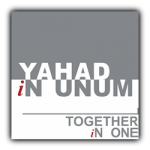 Rohatyn Jewish Heritage is grateful for the ongoing research and documentation work of Yahad – In Unum, and for their generosity in sharing these testimonies from their collection to support our work in Rohatyn. To learn more about Yahad and to support their work, please visit:
Rohatyn Jewish Heritage is grateful for the ongoing research and documentation work of Yahad – In Unum, and for their generosity in sharing these testimonies from their collection to support our work in Rohatyn. To learn more about Yahad and to support their work, please visit:
http://www.yahadinunum.org/
http://yahadmap.org/

